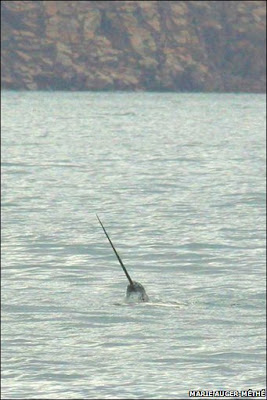In Pictures: Spotting narwhals
 Intriguing photographs of tusk-wielding narwhals have been released by scientists as part of research to develop a way to identify the unicorn-like whales.
Intriguing photographs of tusk-wielding narwhals have been released by scientists as part of research to develop a way to identify the unicorn-like whales.象牙揮舞著的獨角鯨有趣照片,已被科學家放出,作為研究的一部分去開發一種確認似獨角獸的鯨魚的方法。
 The researchers hope to use the nicks and notches present on the dorsal ridge to discriminate between individual animals. Like belugas, narwhals do not have a proper dorsal fin, and their colour changes making identification by other means difficult.
The researchers hope to use the nicks and notches present on the dorsal ridge to discriminate between individual animals. Like belugas, narwhals do not have a proper dorsal fin, and their colour changes making identification by other means difficult. As young narwhals age, they turn from grey to increasingly white. This is one reason why scientists cannot use colour or colour patterns to identify particular whales.
As young narwhals age, they turn from grey to increasingly white. This is one reason why scientists cannot use colour or colour patterns to identify particular whales. The whales travel in large herds which contain smaller groups made up of narwhals of similar age and sex. Here, one of these groups illustrates the difference in patterns on the dorsal ridge that allows scientists to differentiate between animals.
The whales travel in large herds which contain smaller groups made up of narwhals of similar age and sex. Here, one of these groups illustrates the difference in patterns on the dorsal ridge that allows scientists to differentiate between animals. The strange narwhal tusk is a tooth that erupts above the mouth of males (and rarely females). There are many hypotheses why they have them; one thought is that males use tusks to fight or to display to females. Sometimes narwhals can have two tusks.
The strange narwhal tusk is a tooth that erupts above the mouth of males (and rarely females). There are many hypotheses why they have them; one thought is that males use tusks to fight or to display to females. Sometimes narwhals can have two tusks.奇怪的獨角鯨長牙是雄性在口上爆發的牙齒(雌性很少),他們有長牙的原因有很多假設,其中一個想法是,男性使用象牙去作戰或向女性展示。有時獨角鯨可有兩條象牙。
 The ability to identify individuals will enable scientists to know the size of narwhal populations as well as discovering more about narwhal social structure. Here a calf swims close to its mother in the Baffin Island fjords, a common sight in summer.
The ability to identify individuals will enable scientists to know the size of narwhal populations as well as discovering more about narwhal social structure. Here a calf swims close to its mother in the Baffin Island fjords, a common sight in summer. Tusks can reach up to an impressive 3m in length, compared to the 4-5m average body length of a narwhal. The researchers publish their findings in the journal Marine Mammal Science.
Tusks can reach up to an impressive 3m in length, compared to the 4-5m average body length of a narwhal. The researchers publish their findings in the journal Marine Mammal Science.象牙可以達到驚人的3米長,相對於平均4至5米體長的獨角鯨。研究人員在海洋哺乳動物科學雜誌上公佈他們的發現。
http://news.bbc.co.uk/earth/hi/earth_news/newsid_8457000/8457342.stm
Disc:
沒有留言:
發佈留言